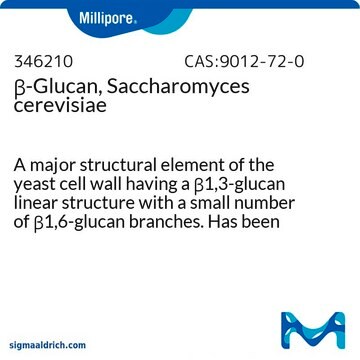67138
β-(1→3)-D-Glucanase from Helix pomatia
≥0.2 U/mg
Sign Into View Organizational & Contract Pricing
All Photos(1)
About This Item
Recommended Products
biological source
Helix pomatia
form
powder
specific activity
≥0.2 U/mg
storage temp.
−20°C
Looking for similar products? Visit Product Comparison Guide
Application
β-(1→3)-D-Glucanase from is used to digest β -1,3-glucan, which is a major component of cell walls. β-(1→3)-D-Glucanase from Helix pomatia has been used fto digest the cell walls of C. albicans .
Biochem/physiol Actions
Deletion of the C.albicans histidine kinase gene (CHK1) improves recognition by phagocytes through an increased exposure of cell wall b-1,3-glucans, which are readily digested by β-(1→3)-D-Glucanases .
Packaging
Bottomless glass bottle. Contents are inside inserted fused cone.
Unit Definition
One unit corresponds to the amount of enzyme which liberates 1 μmol of glucose from laminarin (Cat. No. 61340) per minute at pH 5.0 and 37 °C
Signal Word
Danger
Hazard Statements
Precautionary Statements
Hazard Classifications
Resp. Sens. 1
Storage Class Code
11 - Combustible Solids
WGK
WGK 1
Flash Point(F)
Not applicable
Flash Point(C)
Not applicable
Certificates of Analysis (COA)
Search for Certificates of Analysis (COA) by entering the products Lot/Batch Number. Lot and Batch Numbers can be found on a product’s label following the words ‘Lot’ or ‘Batch’.
Already Own This Product?
Find documentation for the products that you have recently purchased in the Document Library.
Customers Also Viewed
Feng Duan et al.
Sheng wu gong cheng xue bao = Chinese journal of biotechnology, 27(7), 1092-1099 (2011-10-25)
In order to explore the influence of reaction temperature on the product composition, the effect of continuous temperature change (22 degrees C-60 degrees C, +/-0.1 degree C) on hydrolysis of yeast beta-glucan by endo-beta-1,3-glucanase was determined by using self-developed Biochem-temperature
Poonam Gautam et al.
Mycopathologia, 172(5), 331-346 (2011-07-15)
Artemisinin, an antimalarial drug, and its derivatives are reported to have antifungal activity against some fungi. We report its antifungal activity against Aspergillus fumigatus (A. fumigatus), a pathogenic filamentous fungus responsible for allergic and invasive aspergillosis in humans, and its
Nina Klippel et al.
Microbiology (Reading, England), 156(Pt 11), 3432-3444 (2010-08-07)
The pathogenic fungus Candida albicans is able to cover its most potent proinflammatory cell wall molecules, the β-glucans, underneath a dense mannan layer, so that the pathogen becomes partly invisible for immune cells such as phagocytes. As the C. albicans
N P Sachivkina et al.
Bulletin of experimental biology and medicine, 149(6), 727-730 (2010-12-18)
Lyticase (a bacterial enzyme) was tested as a new antimycotic drug. Of all objects studied, Cellulomonas cellulans AC-870 strain proved to be most productive for this enzyme. A technology for lyticase isolation and purification was proposed. An experimental model of
Tomonari Tamashiro et al.
Glycoconjugate journal, 29(1), 77-85 (2011-12-27)
A carbohydrate-binding module from family 13 (CBM13), appended to the catalytic domain of endo-1,3-β-glucanase from Cellulosimicrobium cellulans, was overexpressed in E. coli, and its interactions with β-glucans, laminarin and laminarioligosaccharides, were analyzed using surface plasmon resonance biosensor and isothermal titration
Our team of scientists has experience in all areas of research including Life Science, Material Science, Chemical Synthesis, Chromatography, Analytical and many others.
Contact Technical Service










